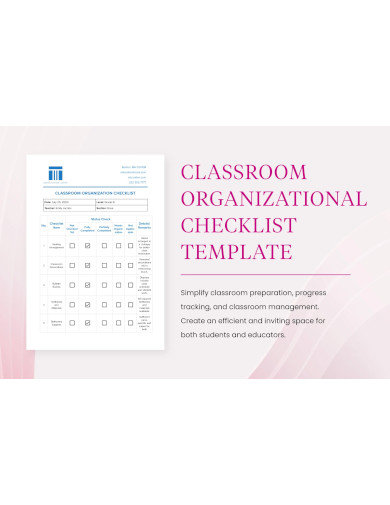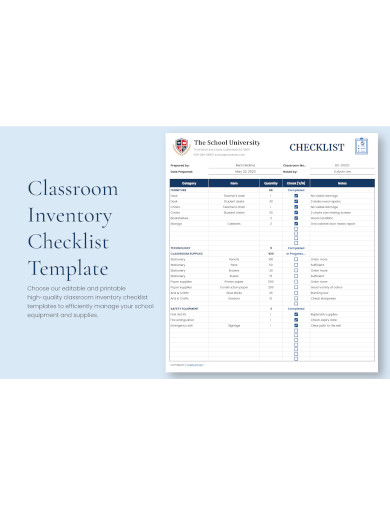25+ Sample Classroom Checklist
-

Classroom Checklist
download now -

Classroom Organization Checklist
download now -

Classroom Materials Checklist
download now -

Classroom Decoration Checklist
download now -

Classroom Inventory Checklist
download now -

Teacher Classroom Checklist
download now -

Classroom Kindergarten Checklist
download now -

Classroom Cleaning Checklist
download now -

Classroom Management Checklist
download now -

Classroom Research Project Checklist
download now -

Daily Classroom Cleaning Checklist
download now -

Classroom Observation Checklist
download now -

Classroom Quality Checklist
download now -

Office Classroom Safety Inspection Checklist
download now -

Classroom Health and Safety Checklist
download now -

Child Care Classroom Checklist
download now -

Early Childhood Classroom Checklist
download now -

Classroom Evaluation Checklist
download now -

Morning Routine Classroom Checklist
download now -

Visual Classroom Checklist
download now -

Classroom Education Checklist
download now -

Classroom Project Checklist
download now -

Virtual Learning Classroom Checklist
download now -

Classroom Checklist Outline
download now -

Classroom Cleanout Checklist
download now -

Simple Classroom Checklist
download now
FREE Classroom Checklist s to Download
25+ Sample Classroom Checklist
What is a classroom checklist?
1. Spatial Arrangement
2. Furniture Essentials
3. Technological Tools
4. Teaching Aids
5. Safety Measures
6. Inclusive Education Tools
7. Interactive Learning Elements
8. Literature Resources
9. Environment and Ambiance
FAQ’S
Does the checklist apply to both traditional and virtual classrooms?
Can the checklist cater to students with special needs?
Is technology a necessary part of the classroom checklist?
How can educators ensure inclusivity in their classroom using the checklist?
How often should the classroom checklist be reviewed or updated?
What is a classroom checklist?
A classroom checklist is a structured document or tool that outlines essential elements and tools needed to create an effective and conducive learning environment. It serves as a guideline for educators and school administrators to ensure the classroom is prepared for optimal student engagement and learning.
1. Spatial Arrangement
Designing the classroom layout to allow seamless transitions between different activities minimizes disruptions and keeps students engaged. A visually appealing classroom can be instrumental in enhancing student motivation and fostering a love for learning.
2. Furniture Essentials
Desks and chairs should be comfortable, promoting good posture and reducing the likelihood of physical discomfort. Adequate storage can reduce clutter, creating a more focused learning environment.
3. Technological Tools
Devices like tablets, projectors, and interactive whiteboards can greatly enhance the learning experience when used effectively. Every student should have equal access to technological tools, fostering an inclusive educational environment.
4. Teaching Aids
Charts, maps, and boards can simplify complex concepts, making them more digestible for students. Tools such as language labs or educational podcasts can cater to auditory learners, diversifying the teaching approach.
5. Safety Measures
Preparedness for emergencies like fires, earthquakes, or lockdowns is non-negotiable for any educational institution. Having a fully stocked first aid kit and trained personnel can swiftly address any medical concerns.
6. Inclusive Education Tools
Accessibility tools like tactile graphics or speech-to-text software can be instrumental in inclusive education. Materials and curriculum should reflect diverse perspectives, promoting understanding and empathy.
7. Interactive Learning Elements
Educational toys, lab equipment, or hands-on projects can appeal to students who learn best through doing. Introducing AR in classrooms can make abstract concepts come to life, providing a more immersive learning experience.
8. Literature Resources
A library stocked with current and diverse materials supports comprehensive learning. E-books and online journals are becoming staples in modern education, offering easy access and interactive features.
9. Environment and Ambiance
A well-lit classroom can boost mood and concentration, with a blend of natural and artificial light being ideal. Good acoustics minimize distractions, ensuring that verbal instructions are clearly heard and understood.
FAQ’S
Does the checklist apply to both traditional and virtual classrooms?
While many elements of a classroom checklist are tailored to traditional physical classrooms, certain aspects, especially regarding technology and resources, can apply to virtual classrooms. There might be a need for specialized checklists catering to each environment.
Can the checklist cater to students with special needs?
Yes, an inclusive classroom checklist would address the specific requirements of students with special needs, ensuring accessibility and providing specialized resources.
Is technology a necessary part of the classroom checklist?
While not mandatory, technology is becoming an increasingly integral part of modern education. Including technology in the checklist ensures that students are provided with current and relevant learning tools.
How can educators ensure inclusivity in their classroom using the checklist?
The checklist can emphasize diverse learning materials, accessible resources, and tools that cater to students of all backgrounds and abilities.
How often should the classroom checklist be reviewed or updated?
Ideally, the checklist should be reviewed at the beginning of each academic term or year. Regular updates might be needed as teaching methods evolve and new tools or technologies become available.
A classroom, at its best, serves as a sanctuary of learning and growth. The aforementioned checklist serves as a roadmap for educators and administrators to create spaces where students are encouraged, challenged, and supported in their academic endeavors. Whether it’s the latest technological tool or a simple, ergonomic chair, every item plays its part in sculpting the future minds of our society.
